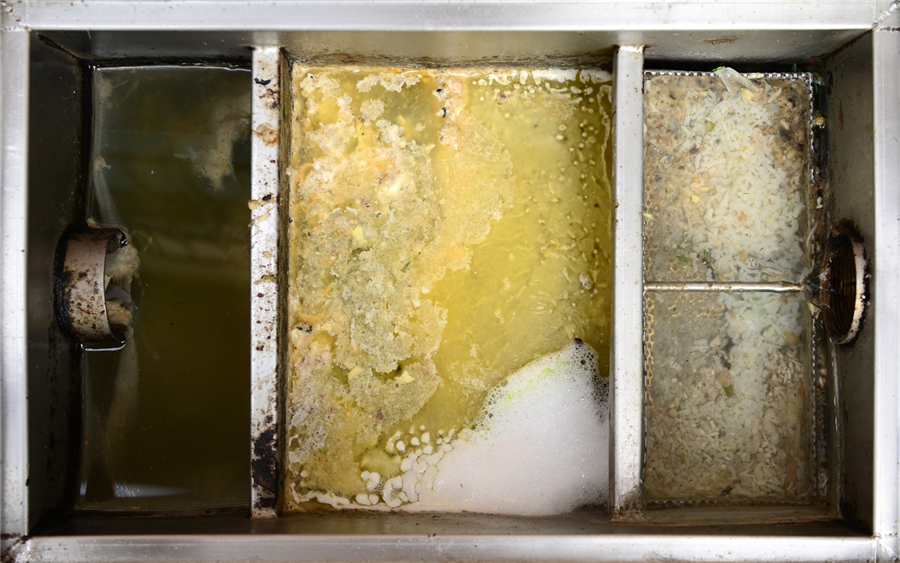
Over 75% of sewer blockages in the UK are caused by fat, oil, and grease (FOG), and the problem has only grown as our eating habits have changed in recent times. However, all businesses that deal with hot food are now required by law to install and maintain a grease trap - a device that captures and separates fats, oils, and grease from the wastewater discharged by commercial kitchens.
A grease trap is designed to prevent these materials from entering and clogging the sewer, which can cause backups and severe blockages (known as fatbergs) that can completely block a sewer pipe.
There are various types of grease traps available, broadly including above-ground grease traps and below-ground grease traps. Some models work automatically to remove FOG from your wastewater, and require little to no regular maintenance. However, for reasons of space, expense and usage, many businesses opt for manual stainless steel grease trap (SSGT) systems that work passively and require regular cleaning.
We’ve put together a handy step-by-step guide to cleaning a grease trap, to help you meet your legal obligations and keep your kitchen and business running smoothly.
How to Clean a Grease Trap
Manual grease traps should be maintained daily and deep cleaned every one to three months, depending on their size and how much they are used. A regular cleaning schedule is the best way to avoid kitchen downtime and unnecessary costs to your business. Makes and models can vary, but most passive grease traps can be cleaned by following these steps.
- Make sure you have the correct tools. You will need protective clothing, a mask, rubber gloves, a plastic scraper, a bucket and scoop, a bin, and some scrubbing brushes. Ideally, you’ll have access to an industrial-grade wet/dry vacuum cleaner too.
- Ensure the trap won’t be used during cleaning. If you have an automatic dishwasher, you will need to switch it off, and sinks will need to be empty.
- Choose the right time. The odours released from a grease trap when the lid is removed can be potent and unpleasant. Cleaning your grease trap is something you will want to do outside of opening hours.
- Remove the lid. Models vary, but the lid of your grease trap could be screwed down or just very tightly clipped, with a seal to stop fumes from escaping.
- Start cleaning. If you have a commercial wet/dry vacuum, you can start removing the water and FOG if your model is rated to cope with the task. Remove the food waste basket and dispose of the contents in your food bin. Use the bucket and scoop to remove as much of the FOG layer as you can, then use the plastic scraper to further remove any stubborn remnants from the trap. There will be other solids at the bottom of the trap that will need to be removed during a deep clean service.
- Avoid hot water and chemicals. Hot water can liquify the FOG and it can pass into the sewer, as can any harsh chemicals. It’s best to use a multi-strain bacteria-based biological cleaning solution as they are kind to the environment and safe to use in grease traps. Scrub the tank of your grease trap until clean.
- Inspect the grease trap, then reassemble it. Check your grease trap for general wear and tear and signs of damage. Replace the lid and ensure any seals, clips and screws are tight.
- Return the grease trap to use. Test the grease trap and if there are no issues, the grease trap cleaning process is now complete.
It’s important to log that the grease trap has been cleaned and dispose of removed FOG with a registered waste removal carrier, ensuring you get a waste transfer note in accordance with Environment Agency rules.
Grease Trap Management by Aqua Mundus
We offer several services to our customers, including a grease trap maintenance and cleaning program for your business. If you’d like more help with cleaning and maintaining your grease trap, you can telephone our expert grease trap services team on 01386 832205. You can also email us if you prefer at emailus@aquamundus.co.uk, or use our online contact form to send us your enquiry.
Aqua Mundus is the UK’s leading grease trap management specialist, and we look forward to helping you with your grease management needs.